Art World
Hit the Road With These 4 Unforgettable Land Art Road Trips, From a Visit to the ‘Lightning Field’ to a Cruise Through the ‘Ghost Ranch’
Art lovers won't want to miss these destinations.
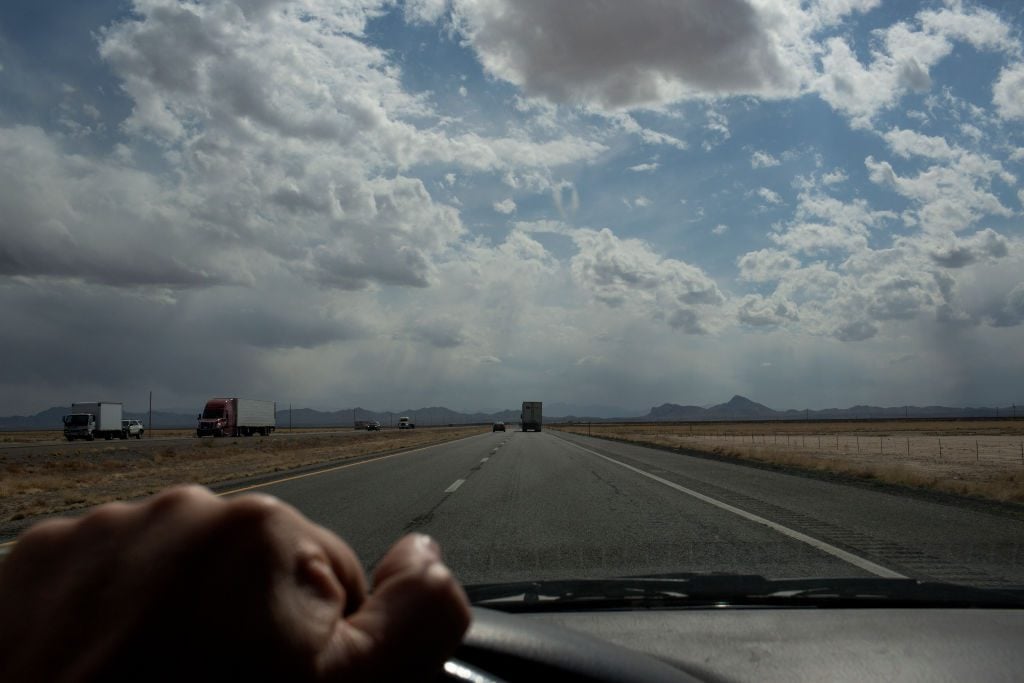
Art lovers won't want to miss these destinations.

Katie White

“There was nowhere to go but everywhere, so just keep on rolling under the stars,” Jack Kerouac wrote in On The Road, forever capturing the enduring mythic freedom of the American road trip.
For art lovers, the perfect road-trip itinerary might be a little more structured than Kerouac’s, however, with visits to iconic Land artworks and sprawling sculpture gardens requiring a wee bit of planning.
But fear not, we’ve got you covered. If you’re ready to hit the road and are looking for the best art itineraries, here are four routes worth considering.
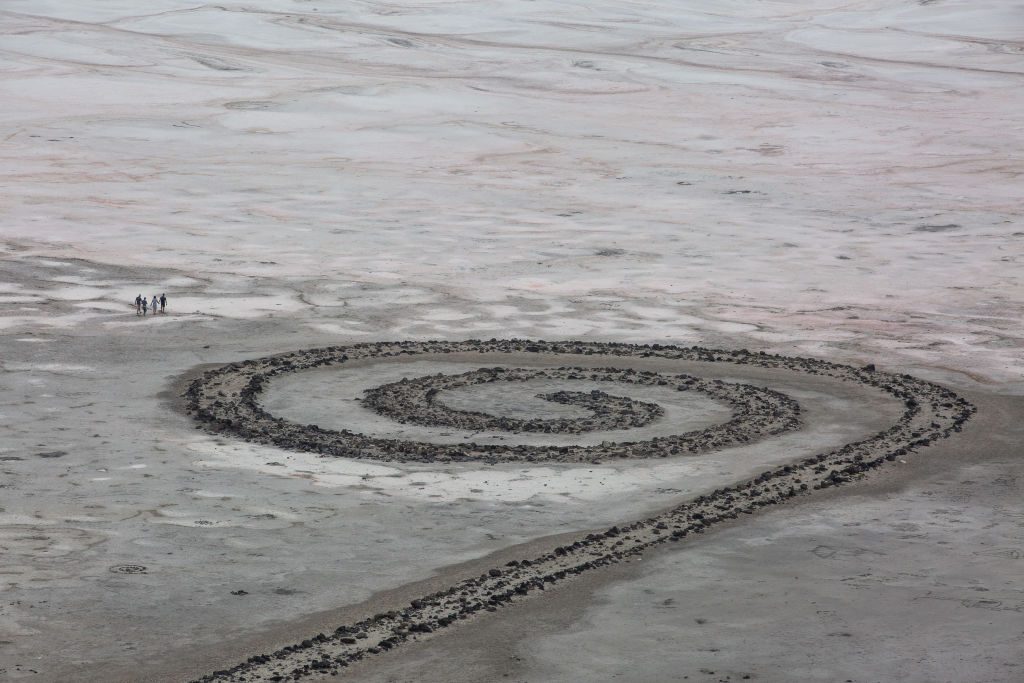
Robert Smithson’s Spiral Jetty earthwork sculpture on the Northern shore of the Great Salt Lake in Utah. Photo: Adam Gray / Barcroft Images (Photo credit should read Adam Gray / Barcroft Media via Getty Images.
Start Your Journey Here: Robert Smithson, Spiral Jetty (1970), Rozel Point Peninsula, Great Salt Lake
What to Know Before You Go: Kick off your journey with a Land Art heavyweight. Robert Smithson’s Spiral Jetty—a 1,500-foot coil of earth and stone that emerges from the waters of the northeastern shore of the Great Salt Lake—is the defining work of the movement, which emerged in the 1960s and ’70s. Smithson made the work using 6,000 tons of black basalt rock and earth from the area, which he piled up using heavy machinery over a period of days in 1970.
Miles on the Road: 103 miles from Salt Lake City, Utah
Next Up: Nancy Holt, Sun Tunnels (1973–76), Great Basin Desert, Utah
What to Know Before You Go: Continue your pilgrimage with Sun Tunnels by Nancy Holt. The installation consists of four massive concrete cylinders—each measuring nine feet high by 18 feet long—arranged in an X-formation in the midst of open landscape in the Great Basin Desert between the Rocky Mountains and the Sierra Nevada range. Holt drilled each of the tubes with holes in the patterns of the constellations of Draco, Perseus, Columbia, and Capricorn. The cylinders are arranged such that on the summer and winter solstices, a pair of the cylinders will align with the setting and rising sun.
Miles on the Road: 105 miles from Spiral Jetty

Double Negative by artist Michael Heizer on January 24, 2021. in Overton, Nevada. (Photo by Josh Brasted/Getty Images)
Grand Finale: Michael Heizer, Double-Negative (1969–70), Carp Elgin Rd, Nevada
What to Know Before You Go: A full day of driving south will bring you to the perfect finale: Michael Heizer’s Double Negative, another pivotal work of Land Art that shouldn’t be missed. Consisting of two trenches dug into the Mormon Mesa, Double-Negative is Heizer’s first prominent earthwork.
Miles on the Road: 438 miles from Sun Tunnels
One for the Future: If your journey south from Sun Tunnels happens sometime in the future, you may aim to glimpse Heizer’s ongoing project City, a monumental temple-like complex that the artist began in 1972 and has been slowly constructing ever since (it’s not yet open public or complete for that matter, so check for updates before you make this trek). It’s about an hour north of Double-Negative.
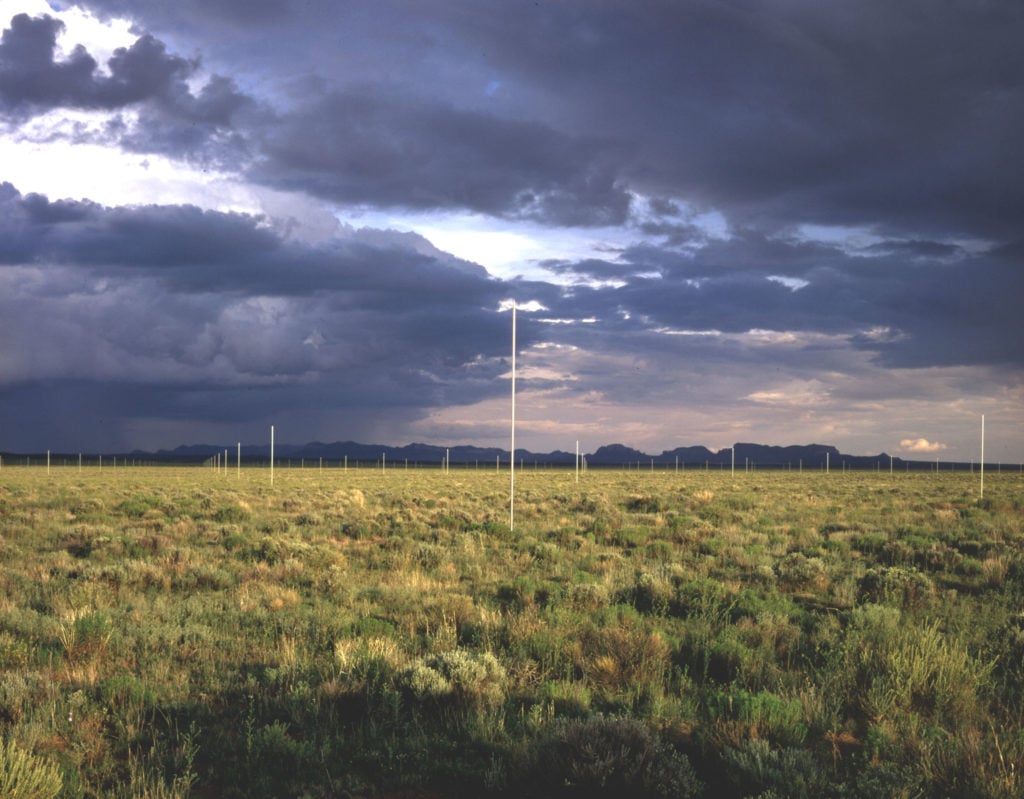
The Lightning Field by Walter de Maria (1977). Photo courtesy of Dia Art Foundation
Start Your Journey Here: Donald Judd, 15 Works in Concrete (1980–84), the Chinati Foundation, Marfa, Texas
What to Know Before You Go: Once a significant US military outpost, Marfa has developed into a veritable art-world pilgrimage site over the past 50 years, thanks largely to the work of Donald Judd. The Minimalist, who discovered Marfa in the 1970s, purchased several large-scale buildings for art installations.
Among these, the Chinati Foundation is perhaps the most iconic and visitors can typically spend the day exploring works by Judd, Dan Flavin, John Chamberlain, Robert Irwin, Roni Horn, and others. Right now, while the galleries are currently closed, the foundation is introducing self-guided walking tours in which visitors can see 15 Works in Concrete (1980–84), which Judd cast and assembled on-site and installed around the perimeter of the property.
Miles on the Road: 192 miles from Midland; 190 miles from El Paso
Plus: Make your social-media followers proud and visit Prada Marfa, the imitation luxury storefront by artists Elmgreen & Dragset, just 37 miles from Chinati.
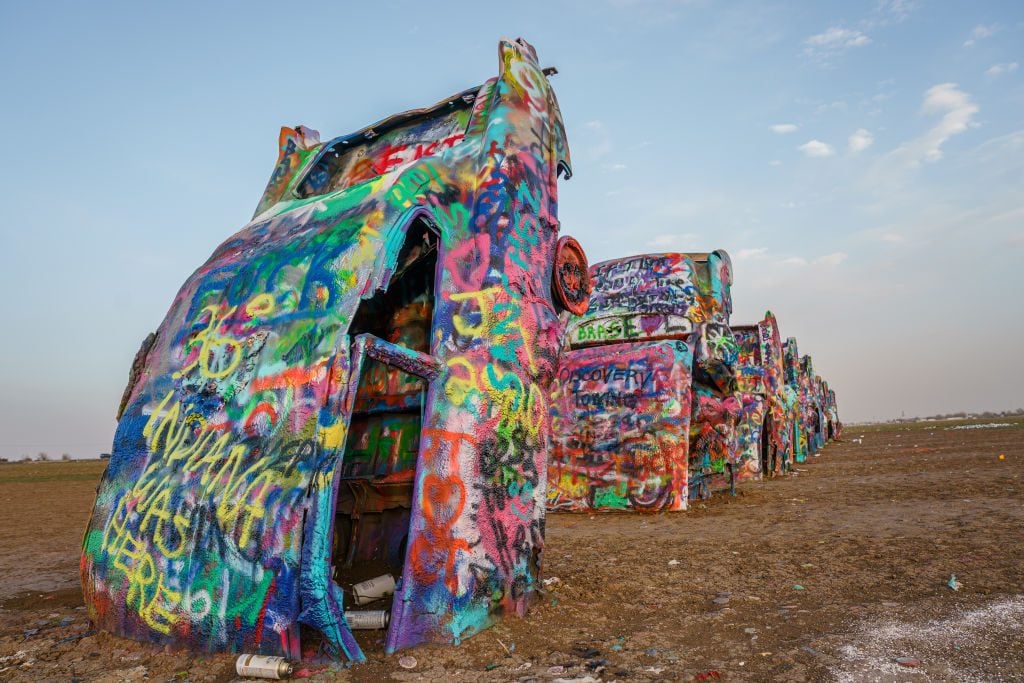
Cadillac Ranch, a public art installation and sculpture created in 1974 by Chip Lord, Hudson Marquez and Doug Michels on December 22, 2020 in Amarillo, Texas. (Photo by Josh Brasted/Getty Images)
Next Up: Cadillac Ranch (1974), Amarillo, Texas
What to Know Before You Go: The tail-ends of ten Cadillacs point upwards out of the dirt in this 1974 work by artists Chip Lord, Hudson Marquez, and Doug Michels, members of the art group Ant Farm, which aimed to subvert norms in architectural practices. The project was famously funded by the local eccentric millionaire Stanley Marsh III, whom the artists entreated for funding in a letter. Visitors often tag the vehicles with colorful graffiti markings. Occasionally the cars are repainted over to make room for new tags.
Miles on the Road: 432 Miles from Marfa
Off-the-Beaten-Path Bonus: By now, you’ll be a true road-trip pro, so clocking 20 more miles to visit Robert Smithson’s lesser-known Amarillo Ramp will be an easy yes. The artist created this curved horseshoe-shape of earth in the dried basin of a lake back in 1973, but erosion has slowly been wearing the work down, so be sure to check this one off your list soon.
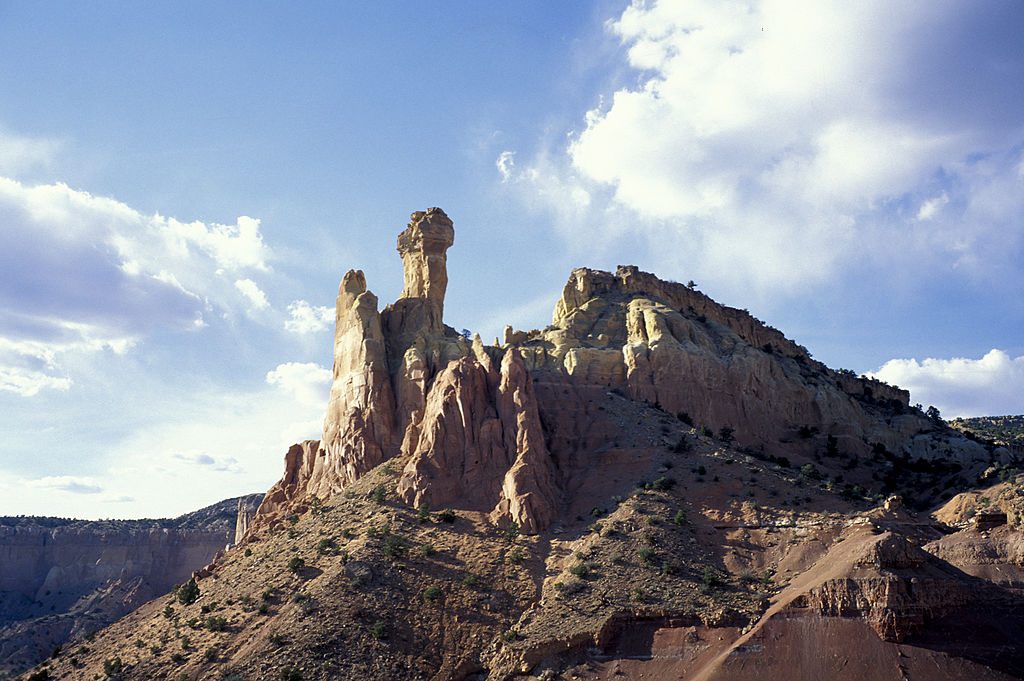
New Mexico, Abiquiu, Balancing Ranch, Ghost Ranch On Rock Hill. (Photo by Education Images/Universal Images Group via Getty Images)
Then Head To: Ghost Ranch, Abiquiú, New Mexico
What to Know Before You Go: Now a 21,000-acre retreat and education center, Ghost Ranch was the home and studio of Georgia O’Keeffe, and the subject of many of her paintings. (The dramatic terrain was also a favorite subject matter for Ansel Adams.) Travelers can explore the red rock terrain on horseback.
Miles on the Road: 317 miles from Cadillac Ranch
Grand Finale: Walter de Maria, The Lightning Field (1977), Quemado, New Mexico
What to Know Before You Go: In the remote distance of the high desert in western New Mexico lies The Lightning Field by the American artist Walter de Maria. The epic outdoor installation includes 400 polished stainless steel poles measuring more than 20 feet tall, each of them placed like perfectly arranged pins in a one-mile-by-one-kilometer grid. Unsurprisingly, the most iconic photos of the work capture lightning striking the work, but those in the know say it’s best to see it at dawn and sunset, when light ricochets dramatically across the field. The site is maintained by the Dia Art Foundation. Given the remote location, guests are required to stay overnight at cabins on the grounds. Plan ahead, as tickets sell out quickly every year.
Miles on the Road: 256 miles from Ghost Ranch
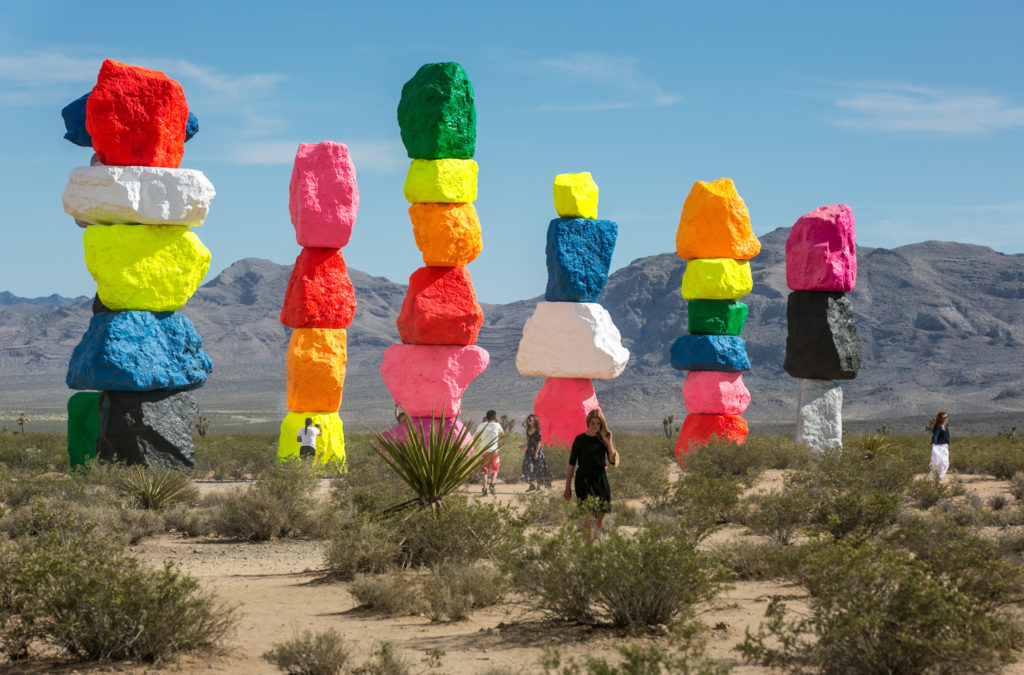
Ugo Rondinone, Seven Magic Mountains. Photo by George Rose/Getty Images.
Start Your Journey Here: Salvation Mountain, Calipatria, California
What to Know Before You Go: Adorned by a giant heart at its center, the dazzlingly colorful Salvation Mountain was created by Leonard Knight, a local artist, who used adobe, straw, and many, many thousands of gallons of paint to transform the mountain into a folk-art (and music-video) destination. Murals, biblical verses, and prayers are scattered across the mountain.
Miles on the Road: 188 miles from Los Angeles
Next Up: Noah Purifoy Outdoor Desert Art Museum
What to Know Before You Go: From 1989 to 2004, Noah Purifoy created this theatrical outdoor installation full of assemblages and found-art objects in the Mojave Desert, just outside of Joshua Tree National Park. The evocative space addresses the complicated history of the American West and is worth a devoted afternoon.
Miles on the Road: 109 miles from Salvation Mountain
Grand Finale: Ugo Rondinone, Seven Magic Mountains (2016)
What to Know Before You Go: Next, travel north towards Nevada where you can check out Ugo Rondinone’s Seven Magic Mountains, seven towers of stacked, fluorescently painted boulders, each climbing up at least 30 feet high. The installation pops brilliantly against the Ivanpah Valley desert and has become an art road-trip favorite. It was originally intended to be removed in 2018, but remains on view.
Miles on the Road: 179 miles from Noah Purifoy Outdoor Desert Art Museum
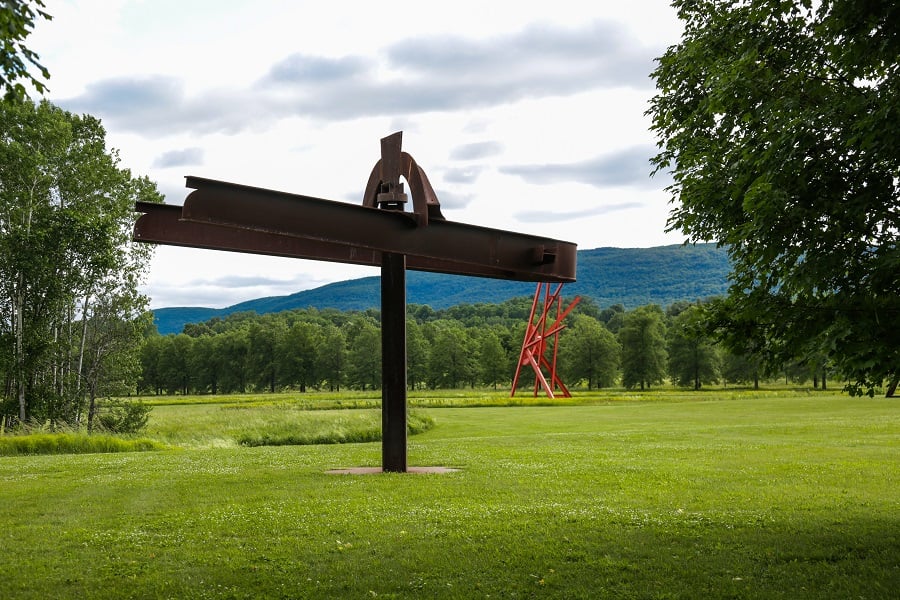
Photo courtesy of Storm King Art Center.
Start Your Journey Here: Storm King, New Windsor, New York
What to Know Before You Go: Visitors could while away an entire day at this sprawling, 500-acre sculpture garden with works by Alice Aycock, Andy Goldsworthy, Mark di Suvero, and many others. For Land Art lovers, Maya Lin’s surreal Storm King Wavefield (2007–08)—a rolling field that looks like waves of water, but made with earth and grass—is an absolute can’t miss. Plan to spend a day—the park is thought to be the largest collection of monumental sculptures in the world.
Miles on the Road: 64.5 miles from New York City
Next Up: Opus 40, Saugerties, New York
What to Know Before You Go: This fascinating bluestone environmental sculpture was made by local quarryman Harvey Fite on his Hudson Valley property. Full of ramps, pedestals, and platforms, the work has a whirlpool-like effect and is positioned on a gorgeous 6.5-acre quarry.
Miles on the Road: 49.5 miles from Storm King
Grand Finale: Art OMI, Ghent, New York
What to Know Before You Go: Further up along the Hudson, this 120-acre sculpture and architecture park is a great place to wander on a summer afternoon. Along with an impressive permanent collection, the park has important seasonal installations too. Oh, and bonus: the grounds are free of charge to the public.
Miles on the Road: 33.6 miles from Opus 40